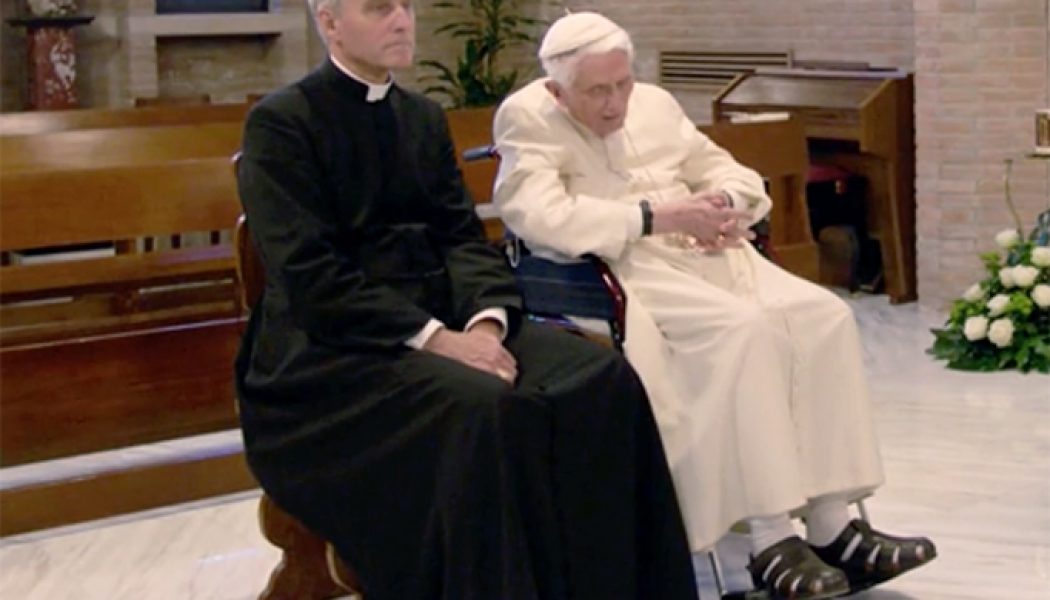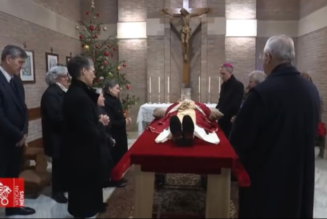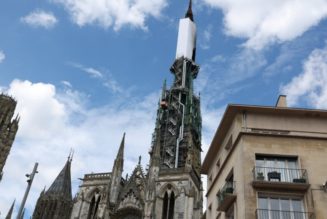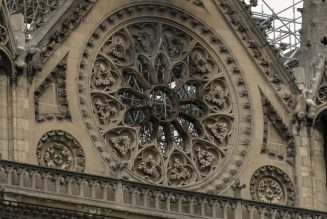
The half-hour documentary, which aired Jan. 3 on German television, is dignified and respectful of the 92-year-old Pope Emeritus.
Benedict XVI appears mentally alert but noticeably frailer and almost unable to speak in a new German television documentary providing a rare glimpse into his daily life.
In the half-hour film aired on Bayerischer Rundfunk (Bavarian state television) on Jan. 3, the 92-year-old Pope Emeritus speaks only three times but in a barely audible voice.
“I used to have a great voice, now it doesn’t work anymore,” Benedict says in the program, which was filmed at his Mater Ecclesiae monastery residence in the Vatican.
“One sees that his strength isn’t there anymore,” his personal secretary Archbishop Georg Gänswein says in the program. “His voice is simply broken, weaker” but he adds that what is “important” to him is “good company” which “lifts his heart” and that he is “at peace with himself.”
His physical appearance has deteriorated considerably over the past couple of years: the documentary shows Benedict thanking guests at his 90th birthday celebration in 2017 with a stronger though still frail voice.
The bulk of the program, entitled “Little Bavaria in the Vatican” and filmed in September, is biographical, recalling Joseph Ratzinger’s childhood, the main events of his life and his personal preferences, interspersed with past interviews with him as cardinal and pope.
Also interviewed on the program is his 95-year-old brother, Msgr. Georg Ratzinger, and Father Bruno Fink, Benedict’s secretary from 1978 to 1983, when Joseph Ratzinger was Archbishop of Munich and Freising.
Most of the commentary is provided by Archbishop Gänswein who takes the viewer around the Mater Ecclesiae residence and is filmed speaking with Benedict in his study surrounded by books and memorabilia, and praying with the former pope in his chapel and on a bench in the Vatican Gardens.
At one point, Benedict and Archbishop Gänswein talk about the writing desk he is sitting at, one which he has used for 65 years. It has “gone a long way” and Benedict wrote most of his works on it, notes Archbishop Gänswein.
Benedict then reveals to a surprised Gänswein that the desk has a secure telephone line installed underneath it, dating back to when Munich was a target of terrorist attacks.
The documentary, made by Bayerischer Rundfunk journalist Tassilo Forchheimer, is dignified and respectful of the former pope, who requires use of a wheelchair due to his knees which cause him considerable pain.
And yet the Pope Emeritus continues to live a disciplined life, routinely rising early as he always has, with Mass celebrated in his private chapel at 7:30 a.m.
We also learn that he still has an appetite for Bavarian desserts but that some of his native and Italian dishes are served on separate days as together would be “too much,” says Archbishop Gänswein.
The meals are cooked by Italian sisters who assist him on a daily basis, but who were “shy” and declined to be filmed or interviewed, according to the program.
The residence contains a good deal of memorabilia from Bavaria, notably photographs of Benedict’s parents and siblings (his sister Maria died in 1991) and a wall painting of one of Benedict’s favorite saints, St. Augustine of Hippo, given to him in 1977 when he was Archbishop of Munich and Freising.
Also hanging on the wall from the sisters is a piece of gingerbread with the words in icing “Dahoam is Dahoam” — Bavarian dialect for “there’s no place like home” — which serves as a reminder of the Bavarian Oktoberfest beer festival.
In the chapel is a replica of the Patrona Bavariae, a statue of the Madonna and Child Jesus, a gift from former Bavarian Prime Minister Edmund Stoiber. The original is located in Munich’s Marienplatz.
The prevalence of Bavarian objects reflects how much his homeland figures in Benedict’s heart as he comes to the end of his life. “I am always very united to Bavaria and every night I entrust our state to the Lord,” he says.
“In my heart, I am always connected with Bavaria,” he says in the documentary’s final words.







